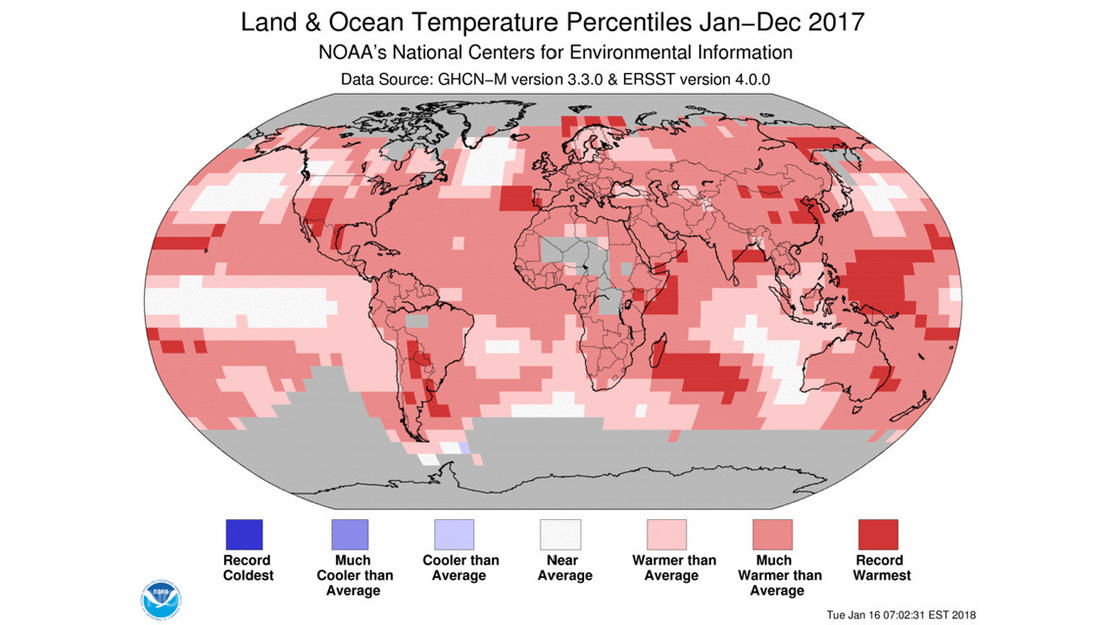Kiwithrottlejockey
Admin Staff
XNC2 GOD

Posts: 32248
Having fun in the hills!
|
from the print edition of the Los Angeles Times....2017 one of 3 hottest years on recordWarming was seen even without El Niño. NASA and NOAA data show ‘long-term trends are very clear’.By AMINA KHAN | Friday, January 19 2018 This color-coded map shows that most of the Earth was warmer than average for the calendar year 2017. — Source: NOAA/NCEI.EVEN WITHOUT the help of El Niño, 2017 was a top-three scorcher for planet Earth. This color-coded map shows that most of the Earth was warmer than average for the calendar year 2017. — Source: NOAA/NCEI.EVEN WITHOUT the help of El Niño, 2017 was a top-three scorcher for planet Earth.
Global temperatures last year were the third-highest since scientists began keeping records in 1880, according to data from the National Oceanic and Atmospheric Administration. Measurements from NASA placed it even higher, coming in second over the last 138 years.
Both agencies said the average global surface temperature in 2017 was only slightly below the record-high temperature seen in 2016.
Two years ago, the average temperature across land and ocean surfaces jumped 1.69 degrees above the 20th century average of 57 degrees, according to NOAA. It remained high last year, coming in at 1.51 degrees above the previous century’s average.
That makes the last three years — 2015, 2016 and 2017 — the hottest ones since 1880. In fact, both analyses agree that five of the hottest years have occurred just since 2010.
“The fact that 2017 was so warm in a year without El Niño should make very clear how rapidly Earth's global temperature is increasing,” said Noah Diffenbaugh, a climate scientist at Stanford University who was not involved with the either NASA's or NOAA’s report.
Although the NASA and NOAA data announced on Thursday have slight statistical differences, they clearly show that global warming continues its climb, scientists said.
“The annual change from year to year can bounce up and down … but the long-term trends are very clear, especially since the mid-20th century,” said Derek Arndt, chief of the monitoring branch of NOAA's National Centers for Environmental Information.
The results were buttressed by analyses from the United Kingdom Met Office and the World Meteorological Organization, which also ranked 2017 as a top-three year for recorded global temperatures.
Apart from a few cold spots, “the planet is warming remarkably uniformly,” said Gavin Schmidt, director of NASA's Goddard Institute for Space Studies, which uses satellites to monitor Earth's climate.
Although global temperatures differed across continents, virtually all of them felt the heat.
South America experienced its second-warmest year since continental records began in 1910, according to NOAA data. Asia felt its third-warmest, Africa its fourth-warmest and Europe its fifth-warmest year on record. North America and Oceania, a region that includes Australia, Polynesia and several other island chains, felt their sixth-warmest years on record.
The record-breaking temperatures in 2016 were fueled slightly by El Niño, a multiyear weather pattern that can result in higher regional temperatures. But 2017 was warm even without that additional help, going through a fairly “neutral” year as the pattern transitioned toward the cooler La Niña phase.
“It was the warmest non-El Niño year on record,” said Michael Mann, a climate scientist at Pennsylvania State University who was not involved with either government analysis.
Data from the National Snow and Ice Data Center showed that Arctic sea ice last year covered 4.01 million square miles. That marks the second-smallest extent since 1979, when records began.
Antarctic sea ice covered only 4.11 million square miles in 2017, breaking the previous record set in 1986 by 154,000 fewer square miles.
Global temperatures have been rising steadily over the last several decades, fueled in large part by emissions of carbon dioxide and other greenhouse gases that result from burning fossil fuels, cutting down forests and other human activity. A map of some noteworthy climate and weather events that occurred around the world in 2017. — Source: NOAA/NCEI.The warming trend has caused sea levels to rise and led to an uptick in extreme weather events, scientists said. A map of some noteworthy climate and weather events that occurred around the world in 2017. — Source: NOAA/NCEI.The warming trend has caused sea levels to rise and led to an uptick in extreme weather events, scientists said.
“We are now clearly seeing the impact of human-caused climate change in the form of unprecedented droughts, wildfires, floods and superstorms,” Mann said. He pointed to a heavy-hitting 2017 season that included Hurricanes Harvey, Irma and Maria. Each of those storms cost the United States far in excess of $1 billion, according to NOAA.
“The effects of climate change are no longer subtle,” he said.
The excess carbon dioxide has also made oceans more acidic, causing long-termdamage to corals and many other marine species, research shows.
Members of the Trump administration have indicated a reluctance to recognize and respond to the threats associated with human-caused climate change. President Trump announced last year that he would be pulling the United States out of the 2015 Paris climate accord.
His administration has also pushed to remove protections from some public lands and to open waters to drilling. Meanwhile, civil servants with climate science and environmental expertise say they're being sidelined.__________________________________________________________________________ • Amina Khan is a science writer covering a broad range of topics, from Mars rovers to linguistics to bio-inspired engineering — but she's perhaps best known for her repeated and brutal attacks on the office snack table. She surfs and snowboards in her spare time.http://enewspaper.latimes.com/infinity/article_popover_share.aspx?guid=0535b327-50aa-4343-8a23-158ef9b2a746
|